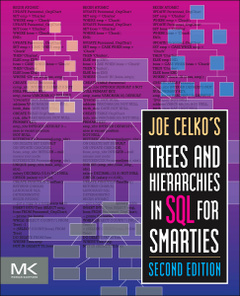Description
Joe Celko's Trees and Hierarchies in SQL for Smarties (2nd Ed.)
The Morgan Kaufmann Series in Data Management Systems Series
Author: Celko Joe
Language: English
Subjects for Joe Celko's Trees and Hierarchies in SQL for Smarties:
Keywords
1; adjacency and depth model; adjacency and nested sets model; adjacency list model; adjacency list with self-references; adjacency matrix model; aggregation; and n; anomalies; application programs; autonumbering; AVL tree; balanced binary search tree; balanced binary tree; breadth-first convergence point; Carl Adam Petri; complete binary tree; computed hybrid models; control blocks; data communications component; data definition language; data field; data type; data validation; database record; deletion; depth-first convergence point; depth-first enumeration; Dewey Decimal Classification system; directed arcs; disjoint hierarchy; DL/I; dynamic edges; dynamic nodes; edge enumeration; edges; Egyptian fractions; EXPLODE operator; Fibonacci tree; floating point numbers; flow lines; Frammis; gaps; greatest common divisor; heaps; height-balanced tree; HIERARCHYID; hybrid models; indegree; inheritance; initial state; inorder traversal; insertion; internal node; isolated node; least common multiple; levels; m; m relationships; Melville Louis Kossuth Dewey; Microsoft; navigation; nested intervals model; nested sets with depth model; node; node enumeration; nodes; nonreconvergent; NULLs; Oracle; organizational charts; outdegree; overlapping hierarchy; parts explosions; path end points; path string; paths; perfect binary tree; places; postorder traversal; preorder traversal; rational numbers; reachable nodes; reconvergent; recursion; recursive common table expressions; relational database; reorganization; root; segment; self-joins; sequence field; shop categories; sink node; source node; spread; stack algorithm; state transition diagram; static edges; static nodes; statistical tools; Stern-Brocot numbers; subordinate adjacency list; subordinates; subordination; subtree; subtrees; superiors; termination states; tokens; transitions; traveling salesman problem; traversal; trees; WITH operator; XML; XPath; ZIP codes
296 p. · 19x23.3 cm · Paperback
Description
/li>Contents
/li>Readership
/li>Biography
/li>Comment
/li>
The demand for SQL information and training continues to grow with the need for a database behind every website capable of offering web-based information queries. SQL is the de facto standard for database retrieval, and if you need to access, update, or utilize data in a modern database management system, you will need SQL to do it. The Second Edition of Joe Celko's Trees and Hierarchies in SQL for Smarties covers two new sets of extensions over three entirely new chapters and expounds upon the changes that have occurred in SQL standards since the previous edition's publication. Benefit from mastering the challenging aspects of these database applications in SQL as taught by Joe Celko, one of the most-read SQL authors in the world.
1. Graphs, Trees and Hierarchies2. Adjacency List Model3. Path Enumeration Models4. Nested Set Model of Hierarchies5. Frequent Insertion Trees6. The Linear Version of the Nested Sets model7. Binary Trees8. Other Models for Trees9. Proprietary Extensions for Trees10. Hierarchies in Data Modelling11. Hierarchical Encoding Schemes12. General Graphs13. Petri Nets14. State Transition Graphs15. Hierarchical Database Systems (IMS)
Mr. Celko is author a series of books on SQL and RDBMS for Elsevier/MKP. He is an independent consultant based in Austin, Texas.
He has written over 1200 columns in the computer trade and academic press, mostly dealing with data and databases.
- Expert advice from a noted SQL authority and award-winning columnist who has given 10 years of service to the ANSI SQL standards committee
- Teaches scores of advanced techniques that can be used with any product, in any SQL environment
- Offers graph theory and programming techniques for working around deficiencies and gives insight into real-world challenges
These books may interest you

Beginning T-SQL 2012 52.74 €



